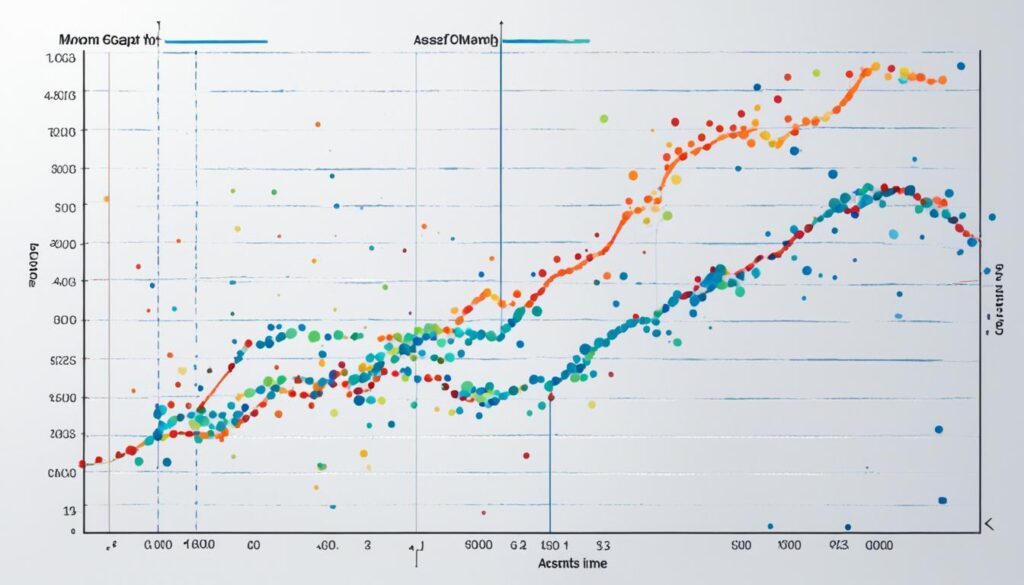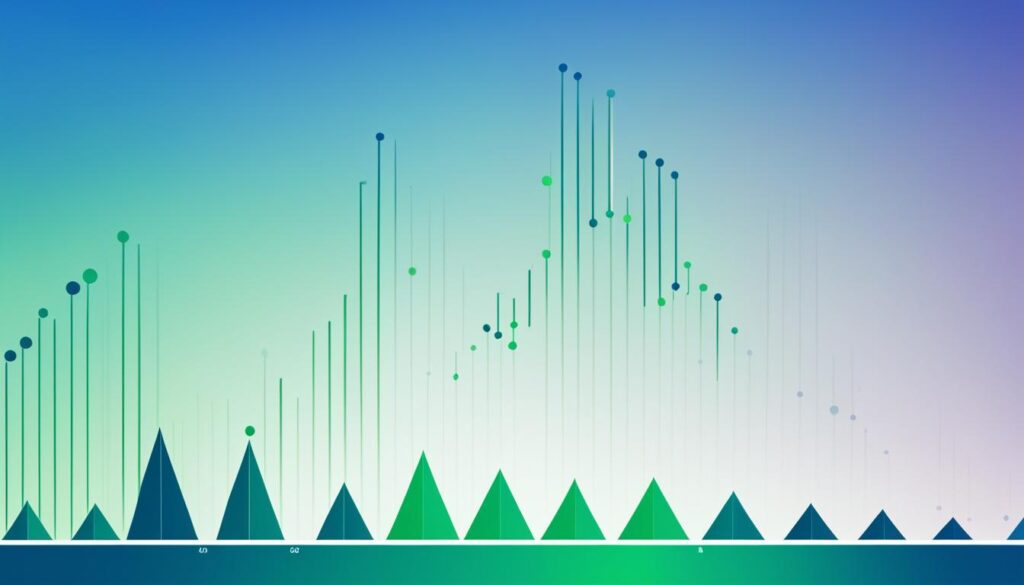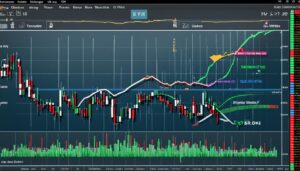When it comes to day trading, having the right indicators is essential for success in the fast-paced trading arena. As a day trader, I understand the importance of using indicators to analyze market data and make informed decisions about buying and selling stocks, currencies, or other financial instruments.
Indicators provide valuable insights into market trends, volatility, and potential trade opportunities. They help me navigate the complex world of day trading by providing a framework for understanding the current market conditions and identifying potential entry or exit points for trades.
In this article, I will share with you some of the essential indicators for day trading that every trader should know about. By incorporating these indicators into your trading strategy, you can increase your chances of success and achieve your financial goals.
Key Takeaways:
- Choosing the right indicators is crucial for successful day trading in the fast-paced trading arena.
- Indicators provide valuable insights into market trends, volatility, and potential trade opportunities.
- Moving averages and the Relative Strength Index (RSI) are two essential indicators for day trading.
- Combine indicators with other analysis techniques to gain a comprehensive understanding of the market.
- Test and refine your trading strategy to find the indicators that work best for you.
Moving Averages
Moving averages are one of the most widely used indicators in day trading. They play a crucial role in helping traders identify trends and potential entry or exit points for their trades. By calculating the average price of a security over a specified period of time, moving averages provide valuable insights into the overall movement of the market.
To visualize moving averages, they are plotted on a chart, allowing traders to easily identify the direction of the trend. This is particularly helpful in day trading, where quick decisions need to be made to capitalize on short-term opportunities.
Traders often use a combination of short-term and long-term moving averages to gain a comprehensive understanding of the market trend. Short-term moving averages, such as the 10-day or 20-day moving averages, react quickly to price changes and are suitable for traders who prefer shorter holding periods. On the other hand, long-term moving averages, such as the 50-day or 200-day moving averages, provide a broader picture of the market trend, making them useful for traders who adopt a more long-term perspective.
By analyzing the positioning and interaction of short-term and long-term moving averages, traders can identify potential buy or sell signals. For example, when the short-term moving average crosses above the long-term moving average, it may indicate a bullish trend, signaling a potential buying opportunity. Conversely, when the short-term moving average crosses below the long-term moving average, it may suggest a bearish trend, indicating a possible selling opportunity.
Overall, moving averages are powerful tools for trend identification and play a significant role in the day trading strategy of many traders. Their simplicity and effectiveness make them a valuable addition to any trader’s toolkit.

Key Points:
- Moving averages help traders identify trends and potential entry or exit points.
- Short-term moving averages react quickly to price changes, while long-term moving averages provide a broader market perspective.
- Combining short-term and long-term moving averages can generate buy or sell signals.
Relative Strength Index (RSI)
In the world of day trading, the Relative Strength Index (RSI) is a well-known and widely used momentum indicator. It provides valuable insights into the speed and change of price movements, allowing traders to identify overbought and oversold conditions in a security. By analyzing the RSI, traders can generate buy or sell signals and identify potential reversal points in the market.
The RSI is measured on a scale from 0 to 100. When the RSI value is above 70, it indicates that the security is overbought, meaning it may be due for a price correction or reversal. Conversely, when the RSI value is below 30, it suggests that the security is oversold, potentially signaling an upcoming price increase.
While the RSI is a powerful tool, it should not be used in isolation. To confirm trading signals and avoid false signals, it is essential to combine the RSI with other indicators or analysis techniques. This holistic approach ensures a more comprehensive understanding of the market and increases the effectiveness of trading strategies.

Key Takeaways:
- The Relative Strength Index (RSI) is a popular momentum indicator used in day trading.
- It measures the speed and change of price movements to determine overbought and oversold conditions in a security.
- Values above 70 indicate overbought conditions, while values below 30 indicate oversold conditions.
- Traders use the RSI to generate buy or sell signals and identify potential reversal points in the market.
- The RSI should be combined with other indicators or analysis techniques to confirm trading signals and avoid false signals.
| RSI Reading | Interpretation |
|---|---|
| Below 30 | Oversold |
| 30 – 70 | Normal |
| Above 70 | Overbought |
Conclusion
In conclusion, the right indicators play a critical role in achieving success in day trading. Two essential indicators that every trader should be familiar with are moving averages and the Relative Strength Index (RSI). These indicators provide valuable insights into market trends, help identify potential entry or exit points, and generate trading signals.
However, it’s important to note that relying solely on indicators is not enough. Traders should combine indicator analysis with other techniques to develop a comprehensive understanding of the market. By incorporating additional analysis tools and strategies, traders can enhance their decision-making process and reduce the risk of false signals.
Each trader may have their own preferred set of indicators based on their trading style, goals, and risk tolerance. It is crucial to test and refine your strategy to identify the indicators that work best for you. Building a solid trading plan that incorporates these essential indicators, along with risk management practices, can significantly increase your chances of success in the fast-paced world of day trading.
FAQ
What are indicators for day trading?
Indicators for day trading are tools used by traders to analyze market data and make informed decisions about buying and selling stocks, currencies, or other financial instruments.
Why are indicators essential for day trading?
Indicators are essential for day trading because they provide valuable insights into market trends, volatility, and potential trade opportunities, helping traders make informed decisions.
What is the purpose of moving averages in day trading?
Moving averages in day trading help traders identify trends and potential entry or exit points for trades. They calculate the average price of a security over a specified period of time and are plotted on a chart.
How do short-term and long-term moving averages differ?
Short-term moving averages react quickly to price changes and are useful for short-term traders. Long-term moving averages provide a broader picture of the market trend.
What is the Relative Strength Index (RSI)?
The Relative Strength Index (RSI) is a popular momentum indicator used in day trading. It measures the speed and change of price movements to determine whether a security is overbought or oversold.
How is the RSI used in day trading?
Traders use the RSI to identify potential reversal points and generate buy or sell signals. Values above 70 indicate overbought conditions, while values below 30 indicate oversold conditions.
Should the RSI be used in isolation?
The RSI should not be used in isolation. It should be combined with other indicators or analysis techniques to confirm trading signals and avoid false signals.
Source Links
- https://www.actionforex.com/live-comments/542027-uk-pmi-manufacturing-finalized-at-47-5-impacts-of-red-sea-crisis-continue/
- https://www.actionforex.com/live-comments/542030-eurozone-cpi-slows-to-2-6-core-down-to-3-1-both-above-expectations/
- https://www.actionforex.com/contributors/technical-analysis/542020-will-gbpjpy-rebound-again/
Disclaimer
All information on this website is of a general nature. The information is not adapted to conditions that are specific to your person or entity. The information provided can not be considered as personal, professional or legal advice or investment advice to the user.
This website and all information is intended for educational purposes only and does not give financial advice. Signal Mastermind Signals is not a service to provide legal and financial advice; any information provided here is only the personal opinion of the author (not advice or financial advice in any sense, and in the sense of any act, ordinance or law of any country) and must not be used for financial activities. Signal Mastermind Signals does not offer, operate or provide financial, brokerage, commercial or investment services and is not a financial advisor. Rather, Signal Mastermind Signals is an educational site and a platform for exchanging Forex information. Whenever information is disclosed, whether express or implied, about profit or revenue, it is not a guarantee. No method or trading system ensures that it will generate a profit, so always remember that trade can lead to a loss. Trading responsibility, whether resulting in profits or losses, is yours and you must agree not to hold Signal Mastermind Signals or other information providers that are responsible in any way whatsoever. The use of the system means that the user accepts Disclaimer and Terms of Use.
Signal Mastermind Signals is not represented as a registered investment consultant or brokerage dealer nor offers to buy or sell any of the financial instruments mentioned in the service offered.
While Signal Mastermind Signals believes that the content provided is accurate, there are no explicit or implied warranties of accuracy. The information provided is believed to be reliable; Signal Mastermind Signals does not guarantee the accuracy or completeness of the information provided. Third parties refer to Signal Mastermind Signals to provide technology and information if a third party fails, and then there is a risk that the information may be delayed or not delivered at all.
All information and comments contained on this website, including but not limited to, opinions, analyzes, news, prices, research, and general, do not constitute investment advice or an invitation to buy or sell any type of instrument. Signal Mastermind Signals assumes no responsibility for any loss or damage that may result, directly or indirectly, from the use or dependence on such information.
All information contained on this web site is a personal opinion or belief of the author. None of these data is a recommendation or financial advice in any sense, also within the meaning of any commercial act or law. Writers, publishers and affiliates of Signal Mastermind Signals are not responsible for your trading in any way.
The information and opinions contained in the site are provided for information only and for educational reasons, should never be considered as direct or indirect advice to open a trading account and / or invest money in Forex trading with any Forex company . Signal Mastermind Signals assumes no responsibility for any decisions taken by the user to create a merchant account with any of the brokers listed on this website. Anyone who decides to set up a trading account or use the services, free of charge or paid, to any of the Broker companies mentioned on this website, bears full responsibility for their actions.
Any institution that offers a service and is listed on this website, including forex brokers, financial companies and other institutions, is present only for informational purposes. All ratings, ratings, banners, reviews, or other information found for any of the above-mentioned institutions are provided in a strictly objective manner and according to the best possible reflection of the materials on the official website of the company.
Forex/CFD trading is potentially high risk and may not be suitable for all investors. The high level of leverage can work both for and against traders. Before each Forex/CFD investment, you should carefully consider your goals, past experience and risk level. The opinions and data contained on this site should not be considered as suggestions or advice for the sale or purchase of currency or other instruments. Past results do not show or guarantee future results.
Neither Signal Mastermind Signals nor its affiliates ensure the accuracy of the content provided on this Site. You explicitly agree that viewing, visiting or using this website is at your own risk.


